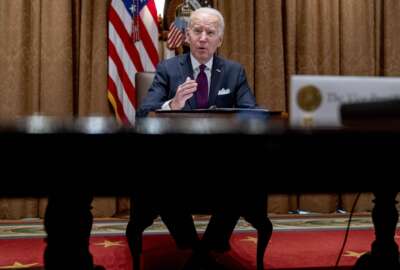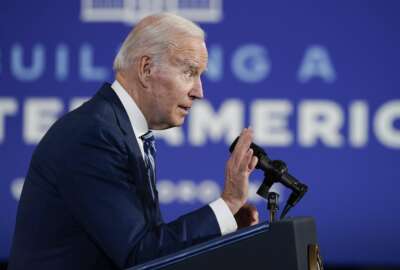
White House permitting plan seeks interagency coordination for infrastructure spending
The Biden administration is looking to accelerate the pace of federal permitting and environmental reviews for thousands of infrastructure projects under the $1...
Best listening experience is on Chrome, Firefox or Safari. Subscribe to Federal Drive’s daily audio interviews on Apple Podcasts or PodcastOne.
The Biden administration is looking to accelerate the pace of federal permitting and environmental reviews for thousands of infrastructure projects under the $1 trillion Bipartisan Infrastructure Law.
The White House last week released a permitting action plan outlining ways agencies can ensure infrastructure spending projects remain on time and on budget.
At the center of this plan is the Federal Permitting Improvement Steering Council, which serves as a coordinating body for infrastructure projects.
Christine Harada, the council’s executive director, said the council is charged with improving the predictability and outcomes of the federal environmental review and authorization process for infrastructure projects across 12 sectors.
The Bipartisan Infrastructure Law marks the largest investment in U.S. infrastructure since World War II. Spending will go toward roads, bridges, freight rail, ports, the electrical grid and internet infrastructure.
“That’s precisely the reason why you need a central coordinating body, because there are indeed a lot of moving pieces. These projects are extraordinarily complex,” Harada said.
An offshore wind project, for example, or a project involving multi-state electricity transmission lines requires a slew of environmental reviews and authorizations that need to go through federal, state, local and tribal government agencies.
“On the federal front, we work closely with these agencies to think through and develop the permitting timetable. So what are these specific authorities that the project needs to obtain, from which agencies, who are the actual specific folks at those agencies who going to be responsible for the project and pulling together the master Gantt chart, as I like to call it, so that we’re able to provide greater transparency and accountability and predictability,” Harada said.
A Gantt chart is a type of bar chart that illustrates the schedule of a project.
The council also maintains Federal Permitting Dashboard on its website that tracks progress on projects funded through the spending bill.
“The information contained there is largely the same. That is, what are all the environmental reviews and authorizations required for that particular project? When did the project start or for particular activities? When do we estimate it’s going to end? It also has subcategory milestones. So, for example, if it’s the midst of the [National Environmental Policy Act] process, when do we think the draft is going to be released? When is the record of decision going to be released?” Harada said.
Congress first created the council in 2015 through the Fixing America’s Surface Transportation (FAST) Act. That legislation, however, called for the council to disband this year.
The Bipartisan Infrastructure Law, however, includes language that makes the council a permanent federal entity.
The council includes 13 agency members, which include the Agriculture, Commerce, Interior, Energy, Transportation, Defense, Homeland Security, and Housing and Urban Development departments.
Council members also include the representatives from the Army, Environmental Protection Agency, the chairs of the Federal Energy Regulatory Commission, Nuclear Regulatory Commission, and the Advisory Council on Historic Preservation, as well as the Office of Management and Budget and the White House Council on Environmental Quality.
Through the greater cross-agency collaboration, the administration expects the council and its members will be able to avoid and resolve potential conflicts and bottlenecks before they emerge.
Harada said agencies, for example, need to be on the same page when it comes to interagency challenges, such as mitigating a project’s impact on endangered species.
“We all want to make sure that we are doing what’s right for the environment and for protecting the species as appropriate. There are certain locations for which that species absolutely needs in order to be able to survive. Frequently for those kinds of situations, it’s a relatively black-and-white case,” Harada said. “But there are also situations where it’s kind of in the shades of gray. So there are certainly parts of the map that are absolutely off-limits. Some parts might be a little bit more hashed-out, if you will. So in that particular case, trying to make the call with the scientists to make sure that we’re doing the right thing is frequently what we’re called to do.”
The permitting plan also seeks to advance the administration’s diversity, equity, inclusion and accessibility goals.
Harada said including disadvantaged, underserved or overburdened communities early in the conversation is essential to delivering infrastructure projects on time.
“Voicing your concerns is how you end up refining the project plan and the project design itself, so that in the end, it’s a better design,” she said.
Aside from putting thousands of infrastructure projects in motion, Harada said the Bipartisan Infrastructure Law has led to a hiring surge in and out of government.
“We need archaeologists, we need biologists. We need scientists and engineers, project planners, financial types in order to do the permitting and siting process. These are all the skill sets that are involved throughout that environmental reviews and authorizations that a project needs to take on,” she said. “So in that regard, that means that there are there’s a tremendous need for folks across both private and public sector to be able to help answer those kinds of questions.”
Copyright © 2025 Federal News Network. All rights reserved. This website is not intended for users located within the European Economic Area.
Jory Heckman is a reporter at Federal News Network covering U.S. Postal Service, IRS, big data and technology issues.
Follow @jheckmanWFED





